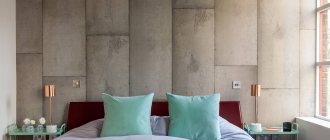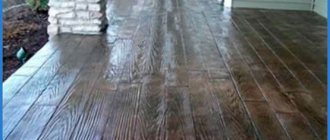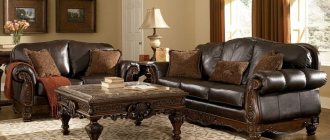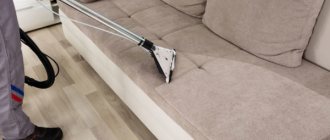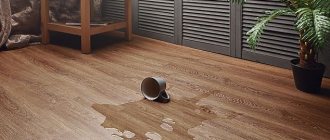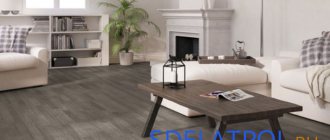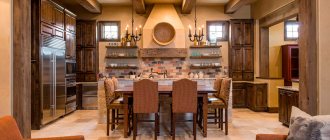Ideal material for the kitchen
The kitchen needs unique finishing materials. This is in many ways a very demanding room, so it is not surprising that the developers, covering all finishing materials, are looking for not only decorative, but also practical solutions.
Concrete meets many modern needs without any problems. This is a very durable, hard and moisture and high temperature resistant material. He doesn't care about any mechanical stress. It is also quite difficult to get dirty or scratched. It does not fade, does not deform, and can be easily scrubbed, although it does not require too frequent cleaning because it does not absorb dirt. In short, the ideal material for the kitchen world.
Glass apron in the kitchen: 25 ideas
Ivan Pozdnyakov designed an interior for a family with three children. The kitchen has a tempered glass splashback.
A glass apron for the kitchen is an alternative to the usual ceramic tiles. It is often used for simple interiors or to protect beautiful wall decoration, such as wallpaper. A glass apron has earned particular popularity for its practicality: due to the lack of seams, there is no place for dirt to accumulate, plus this option is easy to install.
On the subject: Kitchen island: 40 examples for a modern interior
Designers also appreciate the possibility of customization: any pattern can be applied to a glass apron or the surface can be matted. It doesn't have to be transparent. Colored versions are obtained by painting the “wrong side” and subjecting it to heat treatment. The choice of shades is practically unlimited - to suit any interior.
Alexander Ivasiv and Yulia Tkachenko, studio Ater.architects, designed the interior of a two-level apartment in Kyiv.
Bernard Venet and his wife Diana set up a residential museum of modern art in Saint-Germain.
Apartment 60 sq. meters is located in the south of Moscow. The customers wanted a modern interior in the spirit of Scandinavian aesthetics - in light colors and using natural materials. Designer Olesya Berezovskaya from DesignStudio13 was invited to solve the problem. The kitchen was made to order according to the sketches of the author of the project.
Australian architect Simon Pendal, head of Simon Pendal Architect, renovated the townhouse quickly and creatively. He gave each room one color code. Emerald green - for the kitchen.
Elena Paunich designed an apartment in the Khostinsky district of Sochi. The glass of the kitchen splashback reflects the terrace and the surrounding landscape.
Designer Natalya Tikhonova designed the interior of a four-story townhouse in the Parkovy housing complex in Cheboksary.
Tatyana Alenina completed the design of a one-room apartment in the Union Park residential complex. Area - 36 sq. meters.
A young ambitious couple with two children, who value comfort, technical equipment and modern design, turned to Helen and Michael Miroshkin, Geometrix Design, to develop an interior design for a tower on Mosfilmovskaya in Moscow.
The customers, a couple with two Labradors, decided to reconstruct a country house in Voronezh and invited designers Olga Yakovleva and Pavel Stefanov. The apron in the kitchen is decorated with mirror panels.
Tatyana Bobyleva, PROforma project group, transformed an unremarkable one-room apartment of 38 sq. meters into a functional apartment.
Designer Victoria Vlasova designed an apartment of 80 square meters. meters in the Union Park residential complex. The interior was created for rental in the coming years, but in the future the customers planned to use the housing themselves.
Agnes Rudzite’s new project is the reconstruction of a two-story house in Jurmala.
Agnes Rudzite masterfully works with color. But this project, even in her portfolio, can be recognized as bold and bright: in the apartment, which is located in the center of Riga, the designer used the Miami palette.
A godsend for small kitchens - mirror panels. They reflect light, visually enlarge and transform the space even more effectively than a regular glass kitchen splashback. And they can also be processed differently: for example, tinted or aged.
Apartment with an area of 97 sq. meters is located in one of the Kyiv new buildings. The architects of SVOYA Studio called their project Miracle Morning.
Young architect Nildo Jose clearly states his goal: “Architecture must breathe, tell a story and become a landscape for a happy life.” His current project is the Ninho loft at the Casacor decorator show in Sao Paulo.
Domestic Studio created a memorable interior filled with bright solutions. A kitchen apron made of glass painted in a rich wine shade is one of the rare color accents in the apartment.
The German architectural bureau Ippolito Fleitz Group, led by Peter Ippolito and Günter Fleitz, designed the interior of the Chromatic Spaces show apartment.
Evgenia Filatova designed an apartment in New Moscow for a young family with a child. “I felt very sorry for the guys who carried the glass apron up the stairs to the 14th floor: the glass was 3 meters long. They picked it up and brought it into the apartment, but it turned out that the glass had been painted on the wrong side—they had mixed it up at production.”
Alisa Lobanova and Anna Sakharova, Bellardo bureau, designed an apartment for a young entrepreneur who works in the IT field.
Architect Nika Vorotyntseva designed an artistic apartment on the 23rd floor of a Kyiv skyscraper.
Agnes Rudzite completed her new project in Riga in three months. The interior combines laconic lines of Scandinavian design and bright colors.
Designer Natalya Strykova turned an empty concrete “box” into comfortable housing with an unforgettable view from the windows. Faux stone and a gray tinted mirror were used on the kitchen backsplash.
Designers from the studio Agnes Rudzite Interiors decorated an apartment in Riga.
Designer Daryana Mamotenko designed an apartment in a new St. Petersburg residential complex. The mirrored apron in the kitchen was made by Handle Studio.
Type of concrete in the interior
Concrete is typically associated with modern, extremely minimalist interiors. This is a very erroneous impression. It is formed from the perception of an industrial style, full of rigor and economy. However, if you apply a little imagination and the appropriate play of additives and pigments, the result can satisfy the refined tastes of many skeptics.
Concrete in the kitchen provides an excellent backdrop for furniture installation, especially polished cabinets and chrome accessories. He also feels good in the company of wood, glass and even elements made of plastic. Its extremely interesting structure, combined with a smooth surface, creates a vibrant, vibrant contrast full of dynamism.
Concrete is not suitable everywhere
Concrete in the kitchen is increasingly appearing on the walls in the form of a monolithic surface, photo wallpaper or tiles stylized as it. Which shape you choose should largely depend on the style of the kitchen and the atmosphere of the room you want to achieve, but also, above all, on its size.
In small, cramped kitchens there will be little light for such a solution. If your kitchen is not spacious, you should abandon large concrete surfaces in favor of decorative elements made from this material.
Concrete countertop design
Essentially, concrete is an artificial stone. It is created by molding and hardening certain substances. Their mixture consists of cement, sand, water, natural stone and sometimes a coloring pigment. This nature of concrete allows you to create products from it of any, even the most unusual, configuration.
Concrete countertops are great for custom projects. They can be of various shapes and sizes. The only thing that limits the dimensions is transportation and installation. Not every entrance can carry a tabletop 4 meters long.
Concrete products are perfect for both modern and classic room design. They have excellent compatibility with various textures:
- metal;
- tree;
- glass;
- brick;
- and many others.
The addition of various pigments allows you to achieve a beige, gray, pink or green tint to the finished product. But as practice shows, most of our customers want to see concrete in the form of concrete.
Conclusion: if you are a perfectionist and want the countertop to remain in its original form for a long time, then you either need careful operation, or you should order a granite countertop. While concrete is ideal for all fans of loft interiors who are not ready to make any compromises for the sake of style.
Concrete in the kitchen underfoot
When we talk about concrete in the interior, as a rule, the wall surface or concrete tiles come to mind. And this is probably right, because using such material above the countertop, next to the sink or stove, is not only glamorous and fashionable, but also very practical. Concrete in the kitchen, however, can also be successfully used in other areas. It is perfect for the floor. A floor made of polished concrete will not only be original and impressive, but also functional. It is easy to keep clean.
It is worth remembering that polished and treated concrete must be regularly and properly cared for so that it can perform its functions 100%.
Corner kitchen with island
Today, a kitchen with an island is the main design trend. What housewife doesn’t dream of a luxurious set that contains such a universal element? A kitchen island combines three advantages at once. Firstly, it serves as a wonderful work surface and very often has a sink. Secondly, it can be used as a stylish dining area, which allows you to avoid overloading the kitchen with unnecessary furniture. And thirdly, the island is able to effectively zone space, which is especially important for modern studio apartments and loft-style interiors. Practical? More than!
A corner kitchen with an island will look especially striking. Its central element seems to be framed by the facades, and therefore fits organically into the overall composition. If you choose restrained colors for the facades, the kitchen will take on a noble, almost cinematic look.
Custom solutions for concrete
Concrete walls or floors are one thing, but what about kitchen equipment made from these raw materials? Why not? The properties of concrete were appreciated not only by architects, but also by designers of furniture and other elements of the kitchen interior. You can easily find manufacturers of concrete sinks and even kitchen cabinets. This material, like no other, allows you to keep your kitchen clean, does not absorb water and does not react with acid or fruit juices.
Restoring an old countertop using concrete ↑
Concrete can be used not only for the manufacture of a monolithic slab. With its help, it is quite possible to restore an old surface. Moreover, the costs in this case will be much less. Below we will look at how to restore an old kitchen countertop with your own hands.
Required materials ↑
Since a very thick layer is not required in this case, instead of the usual mortar we will use a concrete mixture to screed the floor. For work we will need the following materials:
- concrete mixture for screed (finish);
- acrylic sealant;
- concrete varnish;
- container for preparing the mixture;
- 2 spatulas (20 mm and 10 mm);
- sandpaper;
- industrial mixer;
- Sander.
Note! The amount of concrete mixture must be determined based on the coverage area. Typically, material consumption is indicated on the packaging and averages 1.2-1.5 kg per 1 m² with a layer thickness of 1 mm.
Cement-based floor leveling mixtures
Surface preparation ↑
Kitchen countertops are often made of MDF, which can develop scratches, chips, temperature defects and grease stains during use. Before applying concrete, the surface must be cleaned of all contaminants. Pay special attention to any remaining fat - you can remove it using kitchen detergents. If there is silicone sealant on the surface, then it should also be removed, since concrete has poor adhesion to such materials.
Once the surface is completely clean, it should be sanded with 25-H or 20-H coarse sandpaper. The purpose of this process is to improve the adhesion of the concrete to the old surface by creating multiple scratches. After sanding, the countertop should be washed and allowed to dry thoroughly.
Preparing the surface for concreting
Applying concrete mixture ↑
The technology for making concrete mixture can be read on the packaging. Usually it is diluted with water in a ratio of 2 to 1. The main thing is that the consistency is not too liquid or thick, since in this case the process of applying the solution to the stove will become more complicated.
Advice! First, prepare a small portion of the mixture to determine the amount of water to obtain the optimal viscosity. In the future, strictly observe this proportion. Even minor discrepancies can affect the shade of dried concrete.
Concrete is applied to the surface of the countertop using a wide spatula, while the ends are treated with a narrow spatula. Spread the mixture over the surface using slow and smooth movements to reduce the chance of bubbles forming. The thickness of the applied layer should not be large - 1-2 mm is enough.
Distributing the concrete mixture over the countertop
Grinding concrete ↑
After the layer has completely dried (about 24 hours), the concrete countertop is sanded using coarse sandpaper. Pay special attention to the smoothness of the surface - no unevenness should be felt when moving your hand.
Note! Grinding concrete is quite a dirty job. You need to be prepared for the fact that dust will be everywhere in the kitchen. Therefore, it is better not to do such work without a painting mask.
To make a reliable kitchen countertop with your own hands, you need to apply 3-4 layers of concrete, each of which is sanded after drying. If coarse-grained sandpaper is used to process the first layers, then the last layer, in addition to roughing, is subjected to finishing sanding using fine-grained sandpaper.
Polished surface of concrete countertop
Waterproofing and varnishing ↑
To protect concrete from moisture, a special acrylic-based sealant liquid is used. It is applied with a regular paint brush and, after drying, creates a reliable waterproofing layer. This material absorbs very quickly and dries completely within a day, after which the second and final layer of sealant can be applied.
To ensure that the countertop has a glossy finish, after waterproofing, a layer of concrete varnish is applied, which takes from 4 to 8 hours to dry, depending on the temperature in the room. After the varnish has dried, the slab is polished using fine-grained M14 sandpaper.
DIY concrete countertop for the kitchen
In conclusion, we would like to add that although the manufacturing technology of such a countertop is not particularly complicated, to implement it you must have skills in working with concrete. Therefore, in the absence of such construction experience, it is better to use professional help.
Worthy companions of concrete
In order to soften the severity and coldness of concrete, it is worth using it in combination with other finishing materials. Wooden elements of kitchen furniture are particularly suitable for this. Concrete harmonizes well with the shine of furniture facades, preferably in light, white or neutral tones. In any case, the neutral color scheme of concrete remains the background for any shades.
Bright, rich colors such as red, lime, amaranth and turquoise look very good on this material. A concrete kitchen should have plenty of plant accents. The lush greenery of the flowers allows you to create an atmosphere pleasing to the eye. The overall picture can be complemented by metal or chrome elements, such as a faucet or furniture handles.
